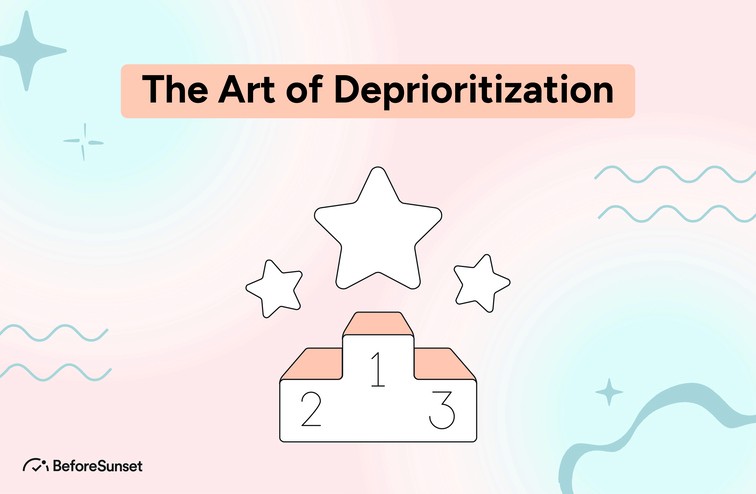Did you know by deprioritizing tasks, professionals can save up to 10.8% of their workweek recovering and catching up from having to reprioritize their work?
Every one of us has a long list of things to do and commitments to do every day. It is often difficult to juggle the many demands placed upon us, both professionally and personally. But what if we told you there was a straightforward method to assist you to get back in the driver's seat and accomplish more with less strain?
Here we have deprioritization!
Deprioritization can simplify your life and increase your productivity by helping you focus on the things that matter most. In this article, we'll dive deep into the topic of deprioritization and provide actionable advice to help you become a deprioritization pro and more easily accomplish your goals.
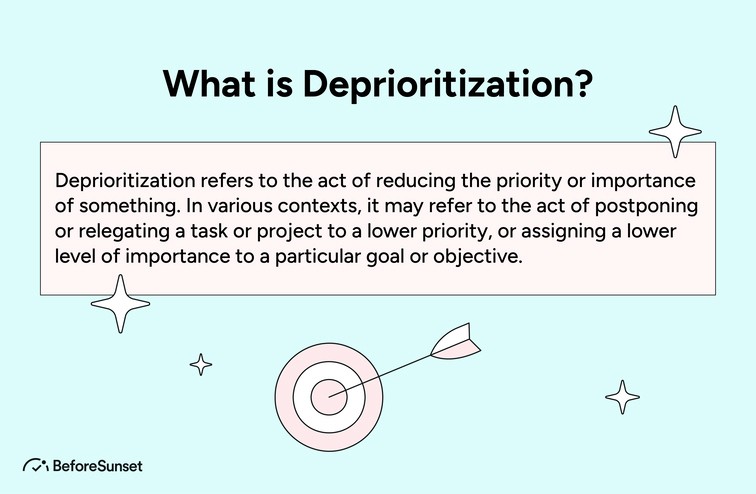
What is Deprioritization?
Deprioritization is one of those big words that simply refers to the act of lowering the level of importance or priority that you assign to something. It's something everyone does at some point in their lives, as when they opt to work on something else because something more pressing or important comes up.
Consider, for instance, the scenario in which you have an upcoming important exam and a separate project that you've been working on. To de-emphasize your side project is to give it less priority and devote less time to it so that you can devote more time to studying for the exam.
You may better manage your time and energy with the help of deprioritization, allowing you to focus on what matters most to you. Finding that sweet spot requires figuring out which considerations are most pressing at any particular time.
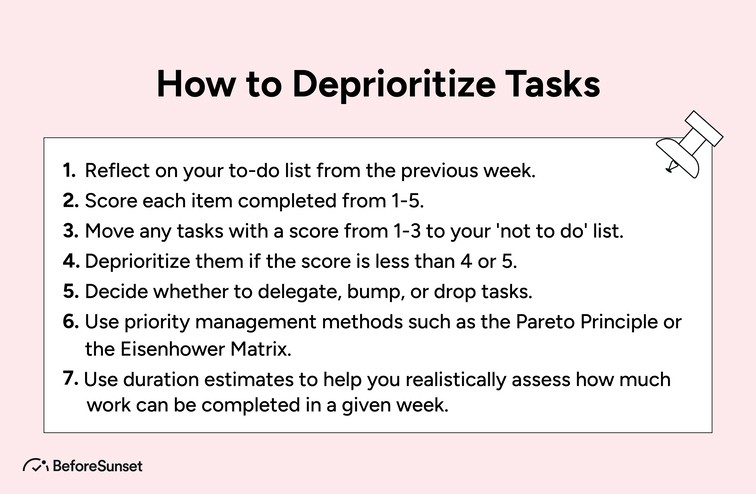
How to Deprioritize Tasks
You want to make sure that you're concentrating on what's most crucial to achieving your goals while also keeping an eye on the wider picture by deprioritizing some chores. In order to manage your workload more effectively and confidently meet your goals, we'll look at several suggestions and tactics for deprioritizing tasks:
It is as important to know which task to be prioritized as to know which task needs to be deprioritized. Here are the steps to help you along the way:
Take 5-10 minutes to reflect on your to-do list from the previous week.
Score each item completed from 1-5 (1 being not a priority, 5 being high priority).
Move any tasks with a score from 1-3 to your 'not to do' list.
For unstarted or partially done items, deprioritize them if the score is less than 4 or 5.
Decide whether to delegate, bump, or drop tasks that don't fit into your schedule.
Use priority management methods such as the Pareto Principle or the Eisenhower Matrix to identify what to prioritize and what to deprioritize.
While time-blocking priorities in your weekly plan, use duration estimates to help you realistically assess how much work can be completed in a given week.
Benefits of Deprioritizing Tasks
With the constant buzz of daily life, we often become overwhelmed with our never-ending to-do lists. We overload ourselves by trying to get everything done at once, which only leads to stress, anxiety, and mediocre outcomes.
This is where deprioritization can work its wonders! By shedding light on what tasks can be placed on the back burner, we can focus our attention and energy on the things that matter most. Here are the many advantages of deprioritizing tasks and how deprioritization can lead to increased productivity, better decision-making, and more balanced life.
So, let's get ready to learn about how taking a step back can help us move forward!
1. It allows you to focus on the most important tasks
By deprioritizing tasks and realigning towards a North Star, you can focus on the most important tasks that will help you reach your future goals.
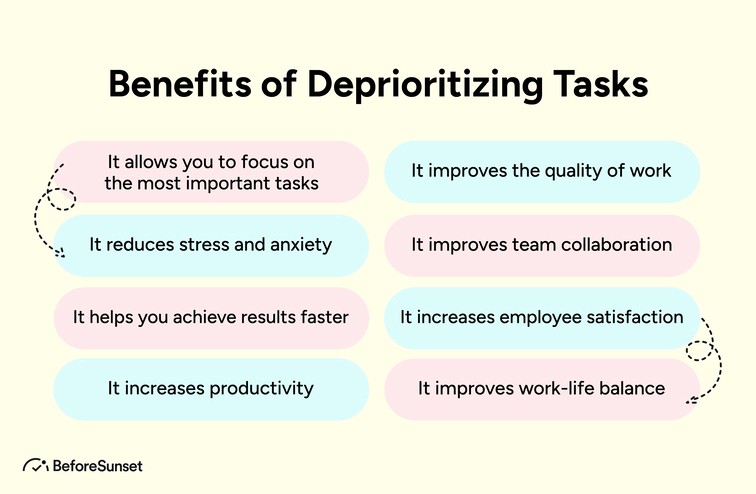
2. It reduces stress and anxiety
Deprioritization of tasks can reduce stress and anxiety by proactively setting boundaries around one's time and bandwidth, learning to respectfully decline projects and meetings that one doesn't have the time for, and allocating time for exercising.
Exercising for as little as 15 minutes per day can extend one's life and enhance sleep quality while planning ahead of time can save up to 10 minutes in execution. Understanding the reasons for time anxiety and establishing a 'flow state' can also increase productivity while reducing stress and exhaustion.
3. It helps you achieve results faster
Prioritizing tasks helps you achieve results faster by allowing you to focus on the most important tasks and deprioritize the rest.
When you take the time to understand the value of each task and optimize your time, you are able to get the best results in the shortest amount of time. Additionally, when you prioritize the parts of a task or project that need to be done and deprioritize the rest, you can:
improve your focus,
increase productivity,
reduce stress,
foster a sense of accomplishment,
and improve your work-life balance.
4. It increases productivity
By deprioritizing tasks, you can save up to 10.8% of your workweek recovering and catching up from having to reprioritize your work. This allows them to create a realistic plan from the get-go, reducing stress and creating a manageable task list. Additionally, deprioritizing can foster a sense of accomplishment when you regularly complete your goals, improve focus on fewer and clearer objectives, boost confidence in your plan, and improve your work-life balance by not overworking yourself.
5. It improves the quality of work
Deprioritizing tasks can improve the quality of work by allowing you to focus on the most important and valuable tasks and avoid the distractions and interruptions that can lead to context switching.
By setting personal boundaries at work and understanding the value of each task, you can save time and energy to focus on the tasks that really matter and ensure the best possible outcomes.
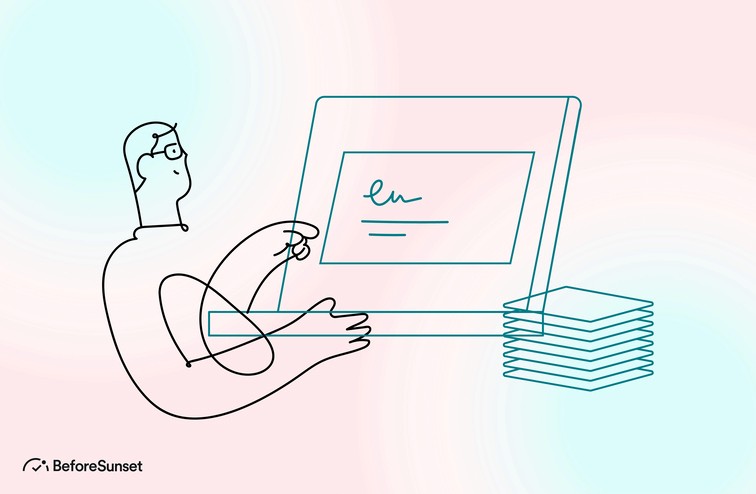
6. It improves team collaboration
When tasks are prioritized, teams can focus on the most important projects and goals and determine how to best use resources to accomplish them. This helps to realign teams and motivate them to achieve better results. Furthermore, people feel more engaged and satisfied with their work, leading to a 13% increase in productivity.
Additionally, prioritizing tasks helps teams to better manage time and avoid overscheduling, as well as optimize external meetings and make them more productive. These strategies can also help to create better working relationships and improved collaboration between team members.
7. It increases employee satisfaction
Deprioritization can have a direct impact on employee satisfaction. When team members have the ability to prioritize and deprioritize their own tasks, they have greater control over their workload and are less likely to become overwhelmed. This can reduce their stress levels and, in turn, improve their job satisfaction.
Furthermore, when employees have their own priorities, they feel more accountable and motivated to complete them. This can lead to greater job satisfaction as they experience a sense of accomplishment, and therefore feel more satisfied with their work.
8. It improves work-life balance
Prioritizing tasks can help improve work-life balance by
creating a manageable task list,
setting clearer objectives,
and boosting productivity.
Deprioritizing also helps reduce time spent recovering and catching up after reprioritizing work. By incorporating deprioritization into effective time management, you can create a realistic plan to reach your goals and reduce the stress of an overwhelming task list. Ultimately, this will create a better balance between work and life, reducing the risk of physical and mental health issues caused by prolonged periods of immense pressure and stress.
Words to Live By: Mastering Priorities Through Deprioritization
By taking the time to understand the value of each task and aligning them with your long-term goals, you can focus on the most important and valuable tasks and avoid the distractions and interruptions that can lead to context switching.
If you want to learn more about how to master your priorities and achieve your goals, check out BeforeSunset!
Remember, deprioritizing can lead to better prioritization and ultimately, success.

